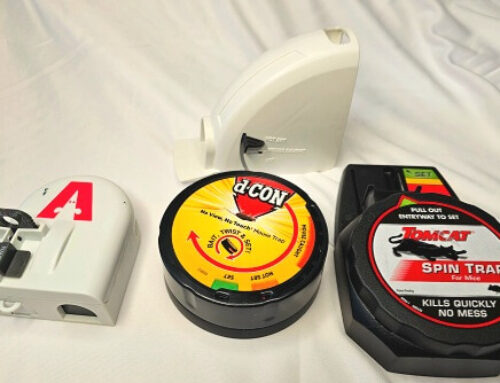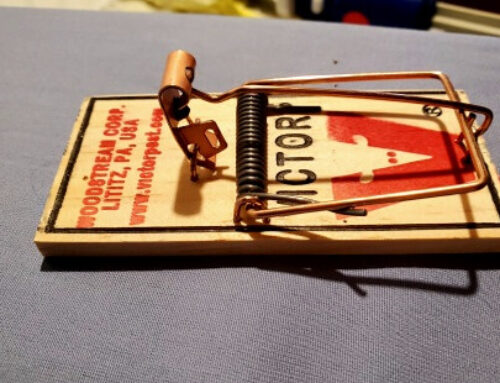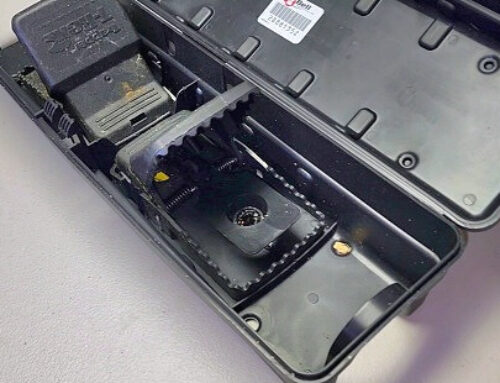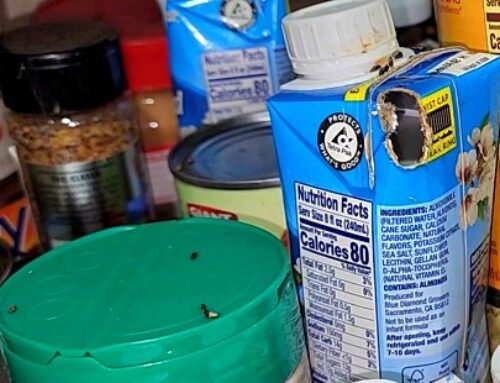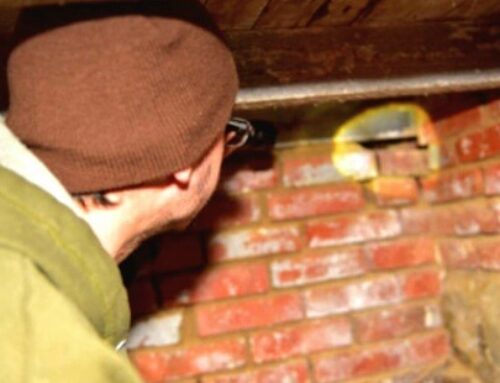Rodent Exclusion Guide For Cleveland, OH Homes
Most people use steel wool or spray foam to stop mice from entering their home. These often work to solve the immediate need. But it looks sloppy and it doesn’t keep them out very long. There are some very effective professional exclusion products that we utilize in our repairs. While this article only touches upon the art of professional rodent exclusion, it aims to provide you with the information to make a better, long lasting repair using store bought materials.
We recommend that you remove the rodents before you seal your home. Then monitor for new activity after the home is mouse proofed.
So how large of a hole can a mouse enter? A mouse can contort its body to fit inside an entry point that is 1/4″ in diameter. That is amazingly small! I think they say the size of a nickel. A man’s pointer finger is just about the diameter hole that a mouse can squeeze through.
Begin by inspecting the most obvious places first. Sometimes it is an easy plug. Other times you really have to dig. Mice might not be entering from cracks along your foundation. They can climb up houses and enter the home from rather high up. All they need is a little bit of traction on a surface, and up they go.
Get A Rodent Control Cost Estimate Emailed To You
If you are trying to solve a rodent infestation on your own, you may not see the value in paying for rodent control. While you may feel that you can set mouse traps on your own, the benefit in hiring a mouse exterminator is to locate potential entry points. It really takes a trained eye to pinpoint all of the places that mice enter homes. Our mouse control service is very thorough, and our exclusion prices are very reasonable. We have ended many age-old rodent battles within a 45 minute service. If you have had enough with mice pooping in your silverware drawer, please contact us.
Where mice get into Cleveland, OH homes.
Check Out All Of The Hot-spots!
Inspecting Homes For Mice- Where To Look
Foundation Wall

When a lot of older homes were built in NE Ohio, they utilized terra cotta foundation block. This is actually very unique. Our region is one of the only areas in the US to have used this type of foundation block. If you ever dropped a clay flower pot, you know that they break easily. A crack in these hollow blocks can create a rodent runway through your walls. The picture displays an example of a broken clay block.
Entry Doors and Garage Doors
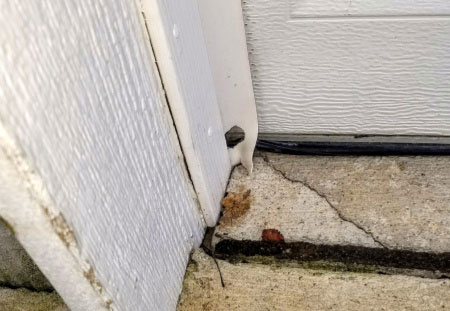
Additionally there are people who leave their garage door open all of the time. We run into this situation fairly often. Keep your garage door closed, especially at night. If it is impractical to seal the garage, then we recommend always keeping mouse traps set in the garage.
Entry doors are also common entry points. Sometimes there is a gap under the door. In that case you need to get a weatherstrip installed. Yet when mice get in through the door, it is usually from gaps around the door frame. Lakewood has a lot of side doors coming off the basement stairs. If you have a door like this, then be sure to check on the sides of the door frame. Also check underneath the threshold for gaps.
Around Steps, Under Porches and Decks
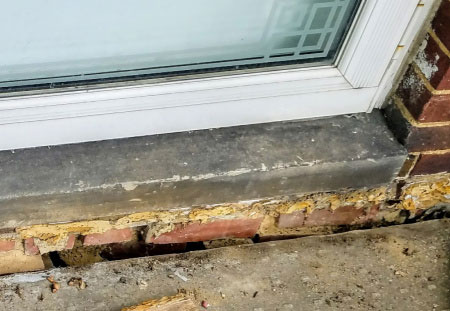
A ledger board is used to attach a porch or deck to a home. This strip of dimensional lumber is bolted horizontally across the home. Inspect this, and any structural supports connected to the home. A popular mouse entry point is where the middle support beam for the front porch attaches to the home.
People with poured concrete steps have rodent problems when the steps settle away from the home. This leaves a gap for rodents to squeeze behind and find a vulnerable point of entry in the actual foundation. Properly repairing gaps behind prefabricated concrete steps can be an difficult. since the steps need to be pulled away from the home for access. This type of issue is shown in the picture.
Make sure you maintain your front stoop. Keep up on the tuck pointing, and repair mortar joints as necessary. Stoops are like a rodent magnet. Chipmunks, mice and rats always try to inhabit these areas.
Under The Bottom Row Of Siding
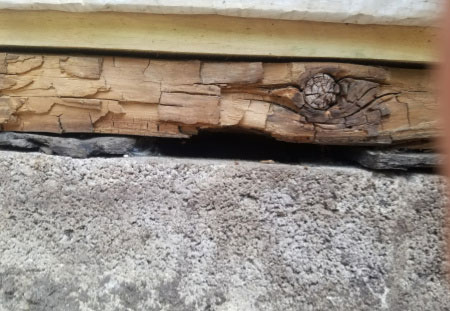
On the outside corners of vinyl siding, there are corner tubes. These hollow tubes give rodents a vertical runway up the house. From there they enter the soffit and attic space. Chipmunks have a fondness for these corner tubes too. You want to screen them, but you still want them to breathe and permeate moisture. We install Kritter caps. Its a great investment if you have vinyl siding and mice in the attic.
Roof Level

Consider mice entering through attic ventilation. Powered attic fans are the most common culprits. They are almost never screened properly. The screens on gable vents deteriorate over time allowing bat, bird and rodent entry. Critters love gable vents with deteriorated screens! Be sure to check soffit vents and ridge vents if you have a mouse infestation in the attic.
Crawlspaces And Additions

Also inspect the junction; where the addition attaches to the original portion of the home. Due to freezing and thawing, this junction often becomes vulnerable to rodent entry. This is probably the second most important place that mice get into Cleveland, OH homes. Be sure to look underneath the siding too. Kitchen additions, often have cinder block foundations. If you stick your hand up there, you may find a big gap on top of the wall- under the siding.
Around Utilities

In addition, check out other areas where utilities enter the home. For example around the water spicket. Dryer vents can have significant gaps around the vent cover. Especially if it is installed through vinyl siding.
Cable lines are a place to check around too. Often the cable guy tucks the cable under siding. Due to this, the bottom row of siding can pop off the track. The siding just flaps around and mice squeak into your walls from there.
Get A Price Quote Emailed To You
How To Seal Where Mice Are Getting Inside
Any gap larger than 1/4″ needs to be sealed. But how do you seal a hole once you find it? There are many different materials that can be used. What is the best choice? The best way to plug an entry point is to match the product with what was originally there. That way you don’t have caulk in your mortar and foam in your caulk.
In order to fill a gap properly, you want to go with a 3 step process. First, fill the void with a backing material. You can use spray foam to fill the hole. But don’t just use that. Rodents can chew through spray foam. Just use it as a filler or backing material. Then enmesh an exclusion material into the foam. Use a stainless steel fabric, or copper mesh. Finally seal over this with a quality sealant. Sealants are different from caulk. Caulk is not rodent proof. It also cracks and peels off over time. Sealants bond to surfaces, giving you a mouse-proof repair.
Mortar Repairs
If the mortar along your foundation is badly deteriorated, tuck pointing may be the proper procedure. You will want to match the new repair with the color of the existing mortar. This type of repair is often best left to a professional. They sell mortar repair in tubes to be applied with a caulk gun. This might be the easiest option for home owners. But if the mortar is falling apart, you have to clean out all of the grit before applying it. Otherwise it won’t adhere to the surface, and you’ll likely just make a mess. For large tuck pointing jobs, we refer our customers to British Stoneworks of Lakewood, OH.
Spray Foam
When you have a rodent hole, it is very easy to fill it up with a can of spray foam. People really think it is great stuff. Its inexpensive and easy to apply. While this is a valid option to fill voids, it should only be used as a filler or backer. Foam should be sealed over because rodents can gnaw through it. It is also not a good option for kitchens since it is porous. It can create an unsanitary condition, when bacteria gets established in it.
There is a brand of spray foam that they sell in stores with a bittering agent in it. This taste repellent works to deter gnawing but it will not stop a rodent from digging it out. Alternatively you can lace your foam with white pepper powder. This helps make it more resistant to rats and mice. If you ever want to find out if a rat is using a hole, put some foam in it. They will rip it into shreds! When applying foam, it is important not to overfill. Spray foam expands. If it does over expand you can push it back in, before it completely cures. Otherwise you can return after it is hard and cut the excess off. When misapplied, foam can be very unsightly.
If you have a smaller crack to fill, they sell backer rod. This is basically a foam rope. They sell it in multiple sizes, to fill smaller gaps, under 2″. This is good for gaps caused by freezing and thawing. Push it into the hole and then apply sealant over top. It can drastically save the amount of caulk/ sealant that you need to apply. They sell it in the weatherproofing aisle of stores.
Exclusion Material
Since you really don’t want to mouse proof your home with caulk and foam, you need something more rodent resistant. This is where copper mesh and Xcluder fabric come in handy. Stuffing holes with these materials alone, isn’t the best since rodents can push it out of the hole. It is best to stuff it into spray foam, and apply a sealant over top of it. Think of it as a sandwich effect. They don’t really sell rolls of this material in stores. When in a pinch, you can always try copper scrubbing pads for dishes. It is a little pricey to do it that way, but it will work if you have a minor repair to make. Copper and Xcluder fabric does not rust and corrode. Which is optimal when sealing for mice outside.
There are other materials that you can use too. 1/4″ hardware fabric is like super fine chicken wire. It works great to repair broken vents. You can also cut and bend it to repair gaps underneath siding.
Sealant
Sealant can be applied to small gaps. You can apply it to a crack in the foundation, and any seam between building materials that is in need of repair. If the hole is large, back it with something first. Mice cannot chew through a high quality sealant. It may be fairly difficult to find in stores. But it is usually there hidden among the caulk and construction adhesives. Sometimes it is in the area with roofing supplies.
Clear sealant is usually the safest bet if you are not a skilled caulker. It is always best to top off repairs with sealant. It gives an extra layer, a finished look, and blocks out water.
Steel Wool
Steel wool is a pretty popular home remedy to block out rodents. Just be aware that steel wool rusts. It shrivels up when exposed to the elements. The rust can drip down and stain your foundation too. Steel wool is best used inside, not outside. Stuff it around the drain pipes under your sink. That sort of application suits it best.


